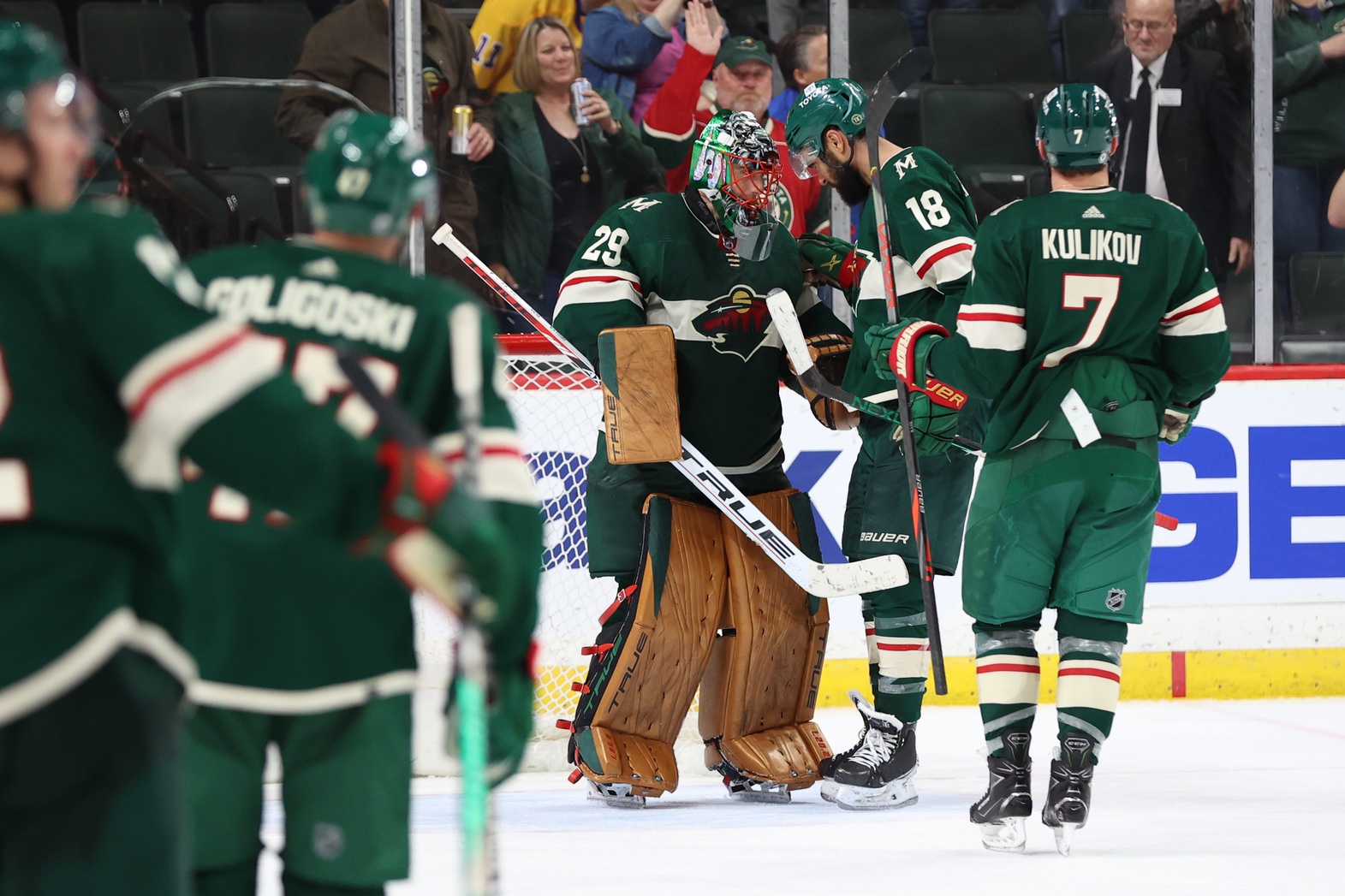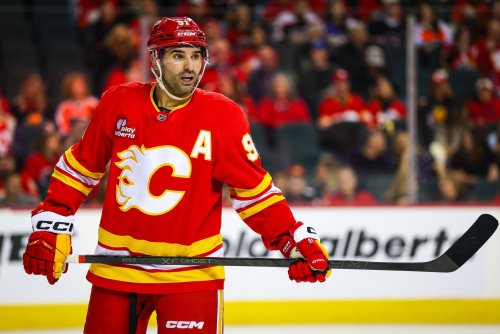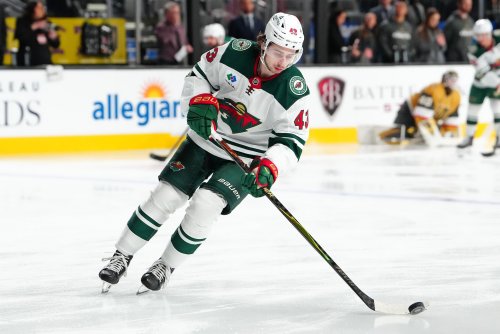
Opening Night is the time of year when most teams, even garbage ones, talk themselves into optimism. Can your perennial loser be a playoff team? Sure, why not? Will your favorite young player become a star? Nah, more like a superstar. Is this the year your playoff team finally wins it all? Could be!
Except this year, expectations are much more tempered in the State of Hockey. Sure, you'd be hard-pressed to find anyone who thinks that Kirill Kaprizov won't challenge for the Hart Trophy, or that top rookie Marco Rossi will fizzle out.
But after a(nother) first-round exit that showed last year's 113-point squad that they weren't ready yet, Stanley Cup Fever isn't hitting Minnesota like it used to. Things like losing Kevin Fiala and having nearly $13 million of dead cap space aren't fueling optimism, either.
Ask the Advanced Stat Community, however, and it's clear they didn't get the memo.
Before the seasons, those in the Hockey Analytics community like to throw out point projections. These aren't subjective, seat-of-your-pants predictions you see most outlets doing before the year starts. These are based on (very complex!) math, with the creators of these models having an informal competition over who will be the most accurate.
Almost universally, these models love the Wild. Evolving Hockey has them projected for 103.6 points, eighth in the NHL. That's one of the more tepid predictions, too. Ask The Athletic's Dom Luszczyszyn, and he has Minnesota as the sixth-best team in the NHL, as does Moneypuck. Micah McCurdy of Hockey Viz projects the Wild for just 96.7 points, but that's the fourth-highest in the league, even above the Cup-winning Colorado Avalanche.
So what's up with that? Why is the opinion nationally more optimistic than it is in Minnesota?
Let's start with the obvious: They were extremely good last season. Most look at the team's 113 points and say they overachieved. Maybe they did. But 113 points is a heck of a cushion if you're expecting Minnesota to regress. Most of these projections are estimating Minnesota will lose something like eight to ten points. That's fine. 103 points is comfortably a playoff team.
While Minnesota rode high last year with their puck luck, it also wasn't that high. At 5-on-5 play, they scored 58% of the goals. That was third in hockey, with only the Calgary Flames and Carolina Hurricanes surpassing them. But it was well-deserved, to a big extent. They controlled 53.7% of the expected goals, which was seventh in the NHL and fairly in line with their actual goal totals.
The Wild also came on strong in the second half. They controlled 55.6% of the expected goal share at 5-on-5 after Matt Boldy got permanently called up. That includes scoring 60.5% of the goals.
We may not see as many goals, and folks like Ryan Hartman and Marcus Foligno may not be able to quite touch what they did last year. Still, the players who overachieved last year are still valuable, even if their shooting percentages normalize.
Sure, Fiala's departure hurts, and they didn't get any immediate help in replacing him. Still, the impact of Fiala wasn't so great that it can tank the team. Fiala drove offense at even strength and drew a lot of penalties. Minnesota will miss that. But he was a slight negative at power play offense, even-strength defense, and taking penalties.
Those things chip into his value just enough that he was worth "only" 4.4 points in the standings last year. We won't lie to you and say that's not a big deal. Five standings points can be a huge swing for a bubble team. But even if Rossi, Tyson Jost, or Sam Steel can't help bridge that gap, that just brings their baseline from 113 points to 108. There's a lot of wiggle room before being in danger of missing the playoffs.
Besides, it's not like the Wild are out of star power. Luszczyszyn rates players on a metric called Game Score Value Added (GSVA), which attempts to translate a player's stats into a win total, similar to Wins Above Replacement. Kaprizov's projected GSVA is 4.1, tied for tenth in the NHL. The Wild are just one of eight teams with a 4-plus GSVA player, all of which are projected at a 64% chance or higher of making the playoffs.
Last season, the Wild's self-declared strength was their depth. That looks to be the case for this season, as well. It's important to have stars giving you a bunch of wins in one burst. It's also important not to have many, or any, players costing you wins. Looking at Minnesota's roster, it's hard to spot weak links.
Luszczysyzn's model identifies only two players with a negative GSVA. They're Brandon Duhaime (-0.2) and Tyson Jost (-0.1). Not only are there just two negative-value players, but their impact is also extremely small. -0.3 wins costs Minnesota, at worst, one point in the standings. They're one of just seven teams with two or fewer players costing them wins by GSVA.
Even better, they're deep among players providing them with two or more wins. Between Kaprizov, Boldy, Mats Zuccarello, Jared Spurgeon, Joel Eriksson Ek, and Marc-Andre Fleury, they've got six such players. The only teams with more? The Florida Panthers, Calgary, and Carolina. They go toe-to-toe with the Toronto Maple Leafs, Colorado Avalanche, Boston Bruins, Pittsburgh Penguins, and St. Louis Blues.
No one has a deeper defensive unit, either. Of the Wild's six starting defensemen tonight, just one, Jake Middleton is projected to provide under one win this season (0.5 GSVA). The Flames are the only other team with five 1.0-win defensemen, and the Flames, Maple Leafs, and Avalanche are the only teams projected to get more wins from their blueline.
So, they have good depth with good numbers. Is there anything else to it? To answer this, we asked a couple of prominent figures in the advanced stats community. The Athletic's Shayna Goldman brought up a couple of strong points we hadn't considered.
"I think there's a little more certainty in net because Cam Talbot was coming off a rough season," Goldman told 10K Rinks. "Plus, Boldy's projection (2.8 GSVA) is really high based on last year, and maybe too high."
It's extremely true that Talbot, despite his reputation as a solid goalie, struggled mightily last year. Evolving Hockey's metrics had him at 0.1 Standings Points Above Replacement, essentially making him no different from an average AHL call-up. Meanwhile, Fleury was worth 3.5 points last season, including 1.8 points in his 11 games with the Wild.
Boldy is also a big wild card, as he had undoubtedly a monster rookie season. But even if Boldy regresses, most project Rossi to be a replacement-level player. If the rookie hits the ground running, that might offset any drop-off from Boldy.
We've leaned on Evolving Hockey's stats and projections throughout this piece, but Josh and Luke Younggren, the minds behind the advanced stats site, lent their insight as well. "We think the Central is really bad this year, so they get to beat up on the Chicago Blackhawks and Arizona Coyotes a lot."
That seems very reasonable. The Wild went 6-1 against those teams last season, and since then, the two bottom-feeders kicked off an incredible tank job. Minnesota has eight games against them, and a 7-1 record gives them a 14-point head start, essentially, to start the season.
Until Minnesota wins its first playoff round since 2015, the postseason will always be a question. But if you were worried about a disaster season, feel free to jump in with both feet. The analytics community tested the pH, and they all agree: the water's fine.
Think you could write a story like this? Hockey Wilderness wants you to develop your voice, find an audience, and we'll pay you to do it. Just fill out this form.






Recommended Comments
There are no comments to display.
Join the conversation
You can post now and register later. If you have an account, sign in now to post with your account.
Note: Your post will require moderator approval before it will be visible.